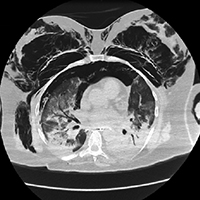Pneumothorax and pneumomediastinum in COVID-19 acute respiratory distress syndrome

Submitted: September 15, 2020
Accepted: March 6, 2021
Published: April 16, 2021
Accepted: March 6, 2021
Abstract Views: 2996
PDF: 1420
VIDEO: 184
VIDEO: 184
Publisher's note
All claims expressed in this article are solely those of the authors and do not necessarily represent those of their affiliated organizations, or those of the publisher, the editors and the reviewers. Any product that may be evaluated in this article or claim that may be made by its manufacturer is not guaranteed or endorsed by the publisher.
All claims expressed in this article are solely those of the authors and do not necessarily represent those of their affiliated organizations, or those of the publisher, the editors and the reviewers. Any product that may be evaluated in this article or claim that may be made by its manufacturer is not guaranteed or endorsed by the publisher.
Similar Articles
- Manas Pratim Roy, Risk factors for Covid-19 in India , Monaldi Archives for Chest Disease: Vol. 92 No. 2 (2022)
- Stefania Paolillo, Giuseppe Luca Della Ratta, Alice Vitagliano, Annapaola Cirillo, Elisabetta Lardino, Tiziana Formisano, Irma Fabiani, Angela Maria Pellegrino, Pietro Riello, Pasquale Perrone Filardi, New perspectives in cardiovascular risk reduction: focus on HDL , Monaldi Archives for Chest Disease: Vol. 80 No. 1 (2013): Cardiac series
- Lorenzo Maria Donini, Eleonora Poggiogalle, Veronica Mosca, Alessandro Pinto, Silvia Migliaccio, Amelia Brunani, Paolo Capodaglio, Critical review of the equations predicting 6-minute walking distance in obese subjects , Monaldi Archives for Chest Disease: Vol. 81 No. 1-2 (2015): Pulmonary series
- Giovanni Capobianco, Cognitive impairment in patients with atrial fibrillation: What is the importance of anticoagulant therapy? , Monaldi Archives for Chest Disease: Vol. 88 No. 2 (2018)
- Alessandra Pratesi, Francesco Orso, Camilla Ghiara, Aldo Lo Forte, Anna Chiara Baroncini, Maria Laura Di Meo, Emanuele Carassi, Samuele Baldasseroni, Cardiac surgery in the elderly: What goals of care? , Monaldi Archives for Chest Disease: Vol. 87 No. 2 (2017)
- Bruno Amato, Mario Santoro, Raffaele Izzo, Giuseppe Servillo, Rita Compagna, Lorenza Di Domenico, Veronica Di Nardo, Giuseppe Giugliano, Evolution of surgical techniques for a progressive risk reduction , Monaldi Archives for Chest Disease: Vol. 87 No. 2 (2017)
- Yusuf Kayar, Nüket Bayram Kayar, Tuncay Şahutoğlu, Venkatanarayana Gangarapu, Spontaneous pneumomediastinum following pneumonia in a 23-year-old male patient , Monaldi Archives for Chest Disease: Vol. 83 No. 1-2 (2016): Pulmonary series
- Yaser Jenab, Marzieh Pourjafari, Maryam Sotoudeh, Masoumeh Lotfi-tokaldany, Nasrin Etesamifard, Shapour Shirani, Arash Jalali, Younes Nozari, Hamid-reza Poorhosseini, Comparing the effect of cardiac biomarkers on the outcome of normotensive patients with acute pulmonary embolism , Monaldi Archives for Chest Disease: Vol. 87 No. 1 (2017)
- Matteo Monami, Sara Aleffi, Hyperglycemia, hypoglycemia and glycemic variability in the elderly: a fatal triad? , Monaldi Archives for Chest Disease: Vol. 84 No. 1-2 (2015): Cardiac series
- Grazia Mazzeo, Luigi Aronne, Domenica Francesca Mariniello, Valentino Allocca, Maria Ilaria Palma, Francesco Saverio Cerqua, Carlo Iadevaia, Adriano Costigliola, Roberto Parrella, Andrea Bianco, Vanvitelli/Monaldi COVID Group, Which impact for proton pump inhibitors in SARS-CoV-2 pneumonia , Monaldi Archives for Chest Disease: Vol. 91 No. 4 (2021)
<< < 23 24 25 26 27 28 29 30 31 32 > >>
You may also start an advanced similarity search for this article.

 https://doi.org/10.4081/monaldi.2021.1608
https://doi.org/10.4081/monaldi.2021.1608





